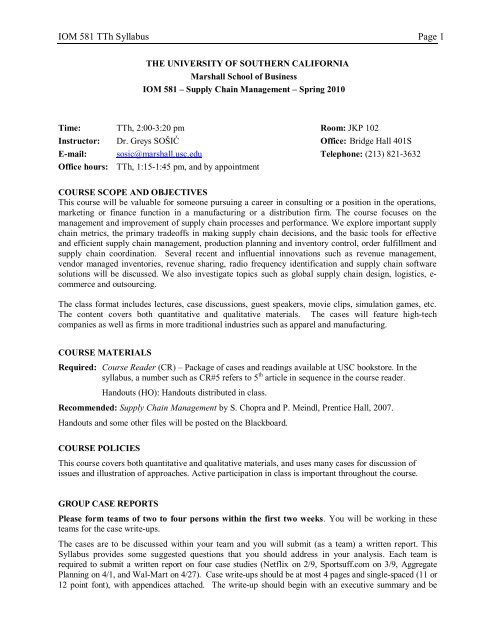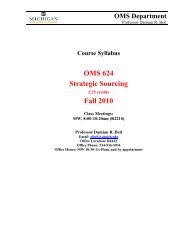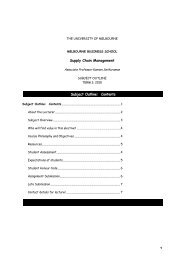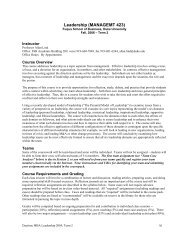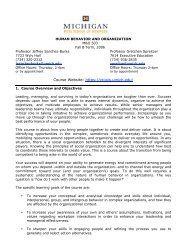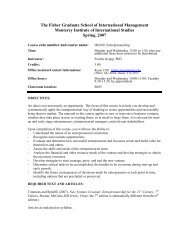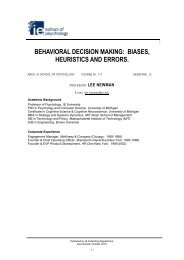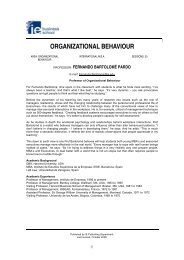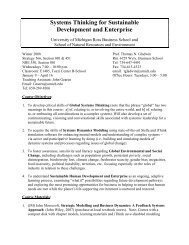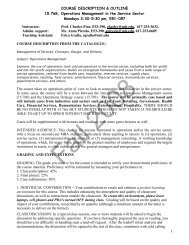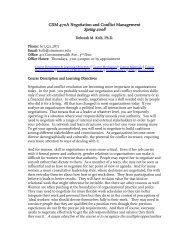Detailed course plan (tentative) - Beyond Grey Pinstripes
Detailed course plan (tentative) - Beyond Grey Pinstripes
Detailed course plan (tentative) - Beyond Grey Pinstripes
You also want an ePaper? Increase the reach of your titles
YUMPU automatically turns print PDFs into web optimized ePapers that Google loves.
IOM 581 TTh Syllabus Page 1<br />
THE UNIVERSITY OF SOUTHERN CALIFORNIA<br />
Marshall School of Business<br />
IOM 581 – Supply Chain Management – Spring 2010<br />
Time: TTh, 2:00-3:20 pm Room: JKP 102<br />
Instructor: Dr. <strong>Grey</strong>s SOŠIĆ Office: Bridge Hall 401S<br />
E-mail: sosic@marshall.usc.edu Telephone: (213) 821-3632<br />
Office hours: TTh, 1:15-1:45 pm, and by appointment<br />
COURSE SCOPE AND OBJECTIVES<br />
This <strong>course</strong> will be valuable for someone pursuing a career in consulting or a position in the operations,<br />
marketing or finance function in a manufacturing or a distribution firm. The <strong>course</strong> focuses on the<br />
management and improvement of supply chain processes and performance. We explore important supply<br />
chain metrics, the primary tradeoffs in making supply chain decisions, and the basic tools for effective<br />
and efficient supply chain management, production <strong>plan</strong>ning and inventory control, order fulfillment and<br />
supply chain coordination. Several recent and influential innovations such as revenue management,<br />
vendor managed inventories, revenue sharing, radio frequency identification and supply chain software<br />
solutions will be discussed. We also investigate topics such as global supply chain design, logistics, ecommerce<br />
and outsourcing.<br />
The class format includes lectures, case discussions, guest speakers, movie clips, simulation games, etc.<br />
The content covers both quantitative and qualitative materials. The cases will feature high-tech<br />
companies as well as firms in more traditional industries such as apparel and manufacturing.<br />
COURSE MATERIALS<br />
Required: Course Reader (CR) – Package of cases and readings available at USC bookstore. In the<br />
syllabus, a number such as CR#5 refers to 5 th article in sequence in the <strong>course</strong> reader.<br />
Handouts (HO): Handouts distributed in class.<br />
Recommended: Supply Chain Management by S. Chopra and P. Meindl, Prentice Hall, 2007.<br />
Handouts and some other files will be posted on the Blackboard.<br />
COURSE POLICIES<br />
This <strong>course</strong> covers both quantitative and qualitative materials, and uses many cases for discussion of<br />
issues and illustration of approaches. Active participation in class is important throughout the <strong>course</strong>.<br />
GROUP CASE REPORTS<br />
Please form teams of two to four persons within the first two weeks. You will be working in these<br />
teams for the case write-ups.<br />
The cases are to be discussed within your team and you will submit (as a team) a written report. This<br />
Syllabus provides some suggested questions that you should address in your analysis. Each team is<br />
required to submit a written report on four case studies (Netflix on 2/9, Sportsuff.com on 3/9, Aggregate<br />
Planning on 4/1, and Wal-Mart on 4/27). Case write-ups should be at most 4 pages and single-spaced (11 or<br />
12 point font), with appendices attached. The write-up should begin with an executive summary and be
IOM 581 Syllabus Page 2<br />
organized as follows:<br />
1. Brief description of the company and its environment<br />
2. Brief description of the problems and issues to be addressed.<br />
3. Recommendations and implementation <strong>plan</strong>.<br />
4. Analysis that discusses why the recommendations will solve the problems identified.<br />
You may choose to organize the report differently; however, please ensure that the above aspects are<br />
covered and the report is well organized with clear section and sub-section headers. Please avoid<br />
repetition of case facts and long expositions. General solutions to specific problems will get you little<br />
credit. Consider what and why you believe are the most important factors. Both quantitative and<br />
qualitative analyses are important. Creativity in analysis and suggestions that are grounded in case facts<br />
will be given high credit. Please state any assumptions made clearly.<br />
The Sportsuff.com and aggregate <strong>plan</strong>ning cases contain less general company information, but posses<br />
more quantitative data. As a result, you need to devote less space to items 1 and 2 listed above. However,<br />
you should build analytical models, develop solutions, and answer the questions posted in the cases. In<br />
addition, as your models are based on the forecasted demand, you should include some sensitivity<br />
analysis of your results; because some costs in the models are estimated, you should provide some what-if<br />
analysis. The reports for those two cases should include a description of your quantitative model; in<br />
particular, for the aggregate <strong>plan</strong>ning case, you should describe all variables and write the objective<br />
function and the constraints. Please include the printout of your spreadsheets, and submit the excel file<br />
along with your write-up (see the instructions for printouts and on-line submissions bellow).<br />
For the Wal-Mart case, each group will be assigned one of the three networks described in the case. You<br />
should prepare a short (2-3 min) presentation of your group‟s answer to question #4.<br />
INDIVIDUAL SUBMISSIONS<br />
In addition to the cases for which you are required to submit group reports, we will be discussing several<br />
cases and articles. You should be prepared for class discussion, and this Syllabus provides some<br />
suggested questions that you should address. For the individual submissions, please prepare a short writeup<br />
(one half to one page long) answering the question(s) listed on p. 5. The objective of this short<br />
submission is to ensure that you prepare the case. For that reason, no late submissions will be accepted.<br />
If you are not able to attend the class, you can submit your assignment online through the Blackboard<br />
before the class. If you are attending the class, please bring a hard copy of your submission and hand it in<br />
at the beginning of the class. As long as your answer shows that you have given sufficient thought to the<br />
analysis, you will get full credit. I will not provide feedback on these submissions (unless your work is<br />
not satisfactory).<br />
EXCEL PRINTOUTS<br />
When printing your Excel file, each spreadsheet should be printed on a single page (let‟s save some<br />
trees!). This can be achieved by using the option Page Layout, Page Setup, Fit to 1 page(s) wide by 1 tall.<br />
ON-LINE SUBMISSIONS<br />
For some of your assignments you will need to submit files showing your work. All on-line submissions<br />
should be made through the Blackboard. The names of the files should contain your name(s) and<br />
assignment number. Do not use symbols such as “#” in naming your files, because the Blackboard does<br />
not support them! For instance, if you are submitting the file for group assignment #2 and your group<br />
members are Black, Brown and White, the file should be called BlackBrownWhite_2.xls. If you do not<br />
follow these guidelines in naming your files, points will be deducted from your grade.
IOM 581 Syllabus Page 3<br />
GROUP ASSIGNMENT EVALUATION<br />
Team assignments provide a valuable learning experience – how to work effectively and efficiently in<br />
groups, learning from others, and honing your ability to communicate to others. Although your team‟s<br />
grade depends on each member‟s efforts, some students can be tempted to let others carry their load. In<br />
order to provide an incentive for all students to make maximum contributions to the study group, you will<br />
be asked to grade each team member‟s contributions. Your group grades will be adjusted to obtain an<br />
individual grade based on feedback about performance provided by other members of the group (see the<br />
group assessment form attached). If you do not submit your group assessment form, it is assumed that you<br />
have assigned a rating of 100% to all your group members.<br />
EXAM<br />
There will be two exams, and each will consist of two parts (with roughly the same weight). The first part<br />
will be qualitative and closed-book, with a combination of multiple choice, short answer and<br />
problem/essay questions, while the second part will be quantitative and open-book.<br />
According to the USC Final Exam Schedule, the final exam is scheduled for May 6, at 2 pm. Please take<br />
this into account when scheduling your trips! If there are extenuating circumstances that prevent you<br />
from taking an exam, you must discuss the reason with me before the time of the exam. You will not<br />
be given a make-up exam unless you obtain a permission from me in advance. In addition, you must<br />
be able to document the extenuating circumstance. If you miss the exam due to a medical emergency<br />
that can be documented and verified, then a make-up exam will be given. Otherwise, a grade of zero<br />
will be given for the missed exam.<br />
CLASS PARTICIPATION<br />
Class participation requires that you do the assigned readings, analyze the cases based on the questions<br />
given and participate actively in class. I prefer substantive comments based on good analysis rather than<br />
brief, general comments that add little to the discussion and learning. If you are reluctant to talk in class<br />
but would like to show your preparation, please provide me with your analysis before class. Be prepared<br />
to defend your suggestions or solutions with careful and thoughtful analysis!<br />
GRADING<br />
Group case reports (4) 28%<br />
Individual submissions (13) 26%<br />
Tests (2) 40%<br />
Class participation 6%<br />
GETTING HELP<br />
If you have questions about any aspect of the <strong>course</strong>, you can always talk to me. If it is a quick question,<br />
you can contact me before or after the class. If you need more time or privacy, you can come to my office<br />
hour. If you cannot make my office hours, you can contact me and we can arrange for an alternative time.<br />
The best way to reach me is by e-mail.<br />
RETURN OF PAPERS AND EXAMS<br />
Graded paperwork that is unclaimed by a student will be discarded after 4 weeks. Students who miss<br />
class sessions when paperwork is returned are responsible for arranging for an appointment to retrieve the
IOM 581 Syllabus Page 4<br />
material. Disputes over graded material should be brought to my attention as soon as possible.<br />
NOTICE ON ACADEMIC INTEGRITY<br />
The use of unauthorized material, communication with fellow students during an examination,<br />
attempting to benefit from the work of another student, and similar behavior that defeats the intent of an<br />
examination or other class work is unacceptable to the University. It is often difficult to distinguish<br />
between a culpable act and inadvertent behavior resulting from the nervous tensions accompanying<br />
examinations. Where a clear violation has occurred, however, the instructor may disqualify the student's<br />
work as unacceptable and assign a failing mark on the paper.<br />
Academic dishonesty includes: (Faculty Handbook, 1994: 21-22):<br />
� Examination behavior - any use of external assistance during an examination shall be considered<br />
academically dishonest unless expressly permitted by the teacher.<br />
� Plagiarism - the appropriation and subsequent passing off of another‟s ideas or words as one‟s<br />
own. If the words or ideas of another are used, acknowledgment of the original source must be<br />
made through recognized referencing practices.<br />
� Other types of academic dishonesty - submitting a paper written by or obtained from another,<br />
using a paper or essay in more than one class without the teacher‟s express permission, obtaining<br />
a copy of an examination in advance without the knowledge and consent of the teacher, changing<br />
academic records outside of normal procedures and/or petitions, using another person to complete<br />
homework assignments or takehome exams without the knowledge or consent of the teacher.<br />
FOR STUDENTS WITH DISABILILITIES<br />
Any student requesting academic accommodations based on a disability is required to register with<br />
Disability Services and Programs (DSP) each semester. A letter of verification for approved<br />
accommodations can be obtained from DSP. Please be sure the letter is delivered to me as early in the<br />
semester as possible. DSP is located in STU 301 and is open 8:30 a.m. - 5:00 p.m., Monday through<br />
Friday. The phone number for DSP is (213) 740-0776.<br />
STATEMENT ON TECHNOLOGY USE<br />
Please note that communication devices such as cell phones, Blackberries, etc. capable of sending<br />
and/or receiving electronic communication and all entertainment devices such as iPods or other MP3<br />
players are to be turned off and kept off throughout the class session. Receiving or sending<br />
communication or entertainment during class disrupts the learning environment and is rude to those<br />
around you. If you use your laptop for note-taking purposes, Internet connections are prohibited unless<br />
otherwise stated by the professor. There will be no use of laptops during examinations.
IOM 581 TTh Syllabus Page 5<br />
Course <strong>plan</strong> at a glance<br />
Date Topic Readings Cases Submission<br />
1 1/12 Introduction to Supply Chain Management<br />
2 1/14 Key Supply Chain Concepts The Seven Principles of Supply Chain Management (CR#1)<br />
3 1/19 Supply chain strategy Zappos (CR#2) short #1 – Zappos (q.#1)<br />
4 1/21 Inventory management – Cycle inventory<br />
5 1/26 Inventory management – Safety inventory Note on Inventory Models (CR#3) §1<br />
6 1/28 Inventory management – Safety inventory Inventory-driven costs (CR#4) short #2 – Inventory-driven cost<br />
(q.#1)<br />
7 2/2 Product availability - Newsvendor model Note on Inventory Models (CR#3) §2 Hamptonshire Express (CR#5) short #3 – Cycle inventory (q.#1-3)<br />
8 2/4 Supply Chain Alignment Note on Inventory Models (CR#3) §3 Hamptonshire Express (CR#5)<br />
9 2/9 Contracts and supply chain performance Netflix (CR#6) group #1 –Netflix<br />
10 2/11 The Bullwhip Effect; VMI The Bullwhip Effect in Supply Chains (CR#7) Barilla SpA (A) (CR#8) short #4 – Barilla (q. #1)<br />
11 2/16 Revenue management Note on the "Retail inventory and pricing game" (HO)<br />
12 2/18 Product design and variety Just-in-time (CR # 9) short #5 –Mass customization (q.#1)<br />
13 2/23 Design for supply chain management<br />
14 2/25 Network design in supply chains Optimization Models for Restructuring BASF North<br />
America‟s Distribution System (CR#10)<br />
15 3/2 MIDTERM<br />
16 3/4 Guest speaker from Nestle short #6 – Inventory centralization<br />
(q.#1,2)<br />
17 3/9 Logistics Note on Logistics in the Information Age (CR#12) short #7 –BASF (q.#3)<br />
18 3/11 Logistics Reverse Logistic Program Design (CR#13) group #2 – sportsuff.com(CR#11)<br />
3/15-3/20 RECESS<br />
19 3/23 Aggregate <strong>plan</strong>ning Aggregate <strong>plan</strong>ning (CR #14) short #8 –Reverse logistics (q.#2)<br />
20 3/25 Forecasting and quick response World Co. (CR #15) short #9– World Co (q.#3)<br />
21 3/30 Demand forecasting Note on forecasting (CR#16)<br />
22 4/1 Demand forecasting Note on forecasting (CR#16) group #3 – Aggregate <strong>plan</strong>ning<br />
problem (HO)<br />
23 4/6 Supplier scorecard Metalcraft (CR#17) short #10 – Metalcraft (q.#2)<br />
24 4/8 Supplier management and outsourcing American outsourcing (CR#18)<br />
short #11 – Li and Fung (q.#2)<br />
25 4/13 Guest speaker from Adexa<br />
26 4/15 IT in supply chains; Enterprise resource<br />
<strong>plan</strong>ning<br />
Li and Fung (CR#19)<br />
Cisco (CR#20)<br />
short #12 –Cisco (q.#1)<br />
27 4/20 E-commerce short #13 –E-commerce (q.#3)<br />
28 4/22 No class (<strong>tentative</strong>)<br />
29 4/27 Sustainability in supply chains Wal-Mart (CR#21) group #4 – Wal-Mart<br />
30 4/29 Class wrap-up<br />
5/6 FINAL EXAM
IOM 581 Syllabus Page 6<br />
<strong>Detailed</strong> <strong>course</strong> <strong>plan</strong> (<strong>tentative</strong>)<br />
1/12 Introduction to Supply Chain Management<br />
1/14 Key Supply Chain Concepts<br />
Readings:<br />
� The Seven Principles of Supply Chain Management, D.L. Anderson, F.F. Britt, D.J. Favre, Supply chain management<br />
review, 1997<br />
� Global supply chain trends 2008-2010<br />
1/19 Supply chain strategy<br />
Case study: (Stanford case #GS65): Zappos.Com: Developing a Supply Chain to Deliver Wow!<br />
Discussion Questions:<br />
1. What are Zappos‟ core competencies and sources of competitive advantage? How sustainable are they? What role<br />
does corporate culture play in these questions?<br />
2. How important is next-day air shipment to the customer experience? Is it worth the cost? How might you change it<br />
in the cost-conscious environment facing the company in late 2008?<br />
3. How would you expand the business? Would you add more products, more geographies, or by selling private labels?<br />
As you expand the business, how can the company become more profitable, particularly in light of the costs<br />
associated with the focus on service?<br />
4. How would you expect the environment of a more cost-conscious consumer to affect Zappos‟ business? What can<br />
Zappos do in such an environment to maintain sales growth?<br />
1/21 Inventory management-Cycle inventory<br />
1/26 , 1/28 Inventory management-Safety inventory<br />
Readings:<br />
� Note on Inventory Models §1<br />
� Inventory-driven costs (HBR #R0503J)<br />
Discussion Questions:<br />
1. What are the hidden costs of inventory? What impact can neglecting these costs have on supply chain<br />
performance?<br />
2/2, 2/4 Product availability-Newsvendor model; Supply chain alignment<br />
Readings:<br />
� Note on Inventory Models §2;3<br />
Cycle inventory assignment: In solving the problems below, it may be best to set up spreadsheets to compute the answers<br />
(please submit it through the Blackboard, and hand in a printout) . In all problems, assume that the annual holding cost is<br />
20% of product cost, h=0.20.<br />
1. Motor Company purchases components from three suppliers: Components from supplier Alpha cost $6 and are used at<br />
the rate 12,000 units/month; components from supplier Beta cost $4 and are used at the rate 3,000 units/month;<br />
components from supplier Gamma cost $5 and are used at the rate 1,000 units/month. The trucking company is charging<br />
a fixed cost of $500/truck. Currently, they purchase separate truckloads from each supplier. What is the corresponding<br />
minimal annual cost? What is the cycle inventory of each component?<br />
2. Motor Company is considering aggregating orders from all three suppliers. In addition to $500 fixed truck cost for<br />
deliveries with one pickup, the trucking company is charging $100 for each additional pickup. What is the corresponding<br />
minimal annual cost? What is the cycle inventory of each component?<br />
3. Motor Company purchases 25,000 units/month from supplier Delta. Delta is offering an all-unit quantity discount as<br />
follows: the unit item cost for orders under 25,000 units is $2, $1.90 for orders between 25,000 and 50,000, and $1.80 for<br />
orders over 50,000. The trucking company is charging a fixed cost of $500/truck. What is the optimal lot size? What is<br />
the cycle inventory? What would be the cycle inventory if there were no quantity discounts and unit price was $1.80?
IOM 581 Syllabus Page 7<br />
Case study: (HBS #9-698-053): Hamptonshire Express – in-class exercise<br />
(Bring your laptops to class. Please download the required files to your laptop before the class)<br />
2/9 Contracts and supply chain performance<br />
Case study: (Olin case): Netflix, Inc. – Video Rental Developments and the Supply Chain<br />
Discussion Questions:<br />
1. Provide a brief comparison between a national chain, such as Blockbuster, and a local independent store.<br />
2. What are the pros and cons of the revenue-sharing contract used by Blockbuster on VHS tapes versus its earlier<br />
practice? Consider the following:<br />
a. How does a revenue sharing contract affect Blockbuster‟s inventory stocking policy and service level on<br />
VHS? You may use the newsvendor model provided on worksheet “Newsvendor” to support your intuition.<br />
Feel free to experiment with different parameters.<br />
b. Is revenue sharing always a win-win to Blockbuster and studios? Experiment with different contract term<br />
settings by varying numbers in Exhibit 3. Excel version of Exhibit 3 is available on worksheet “Rev.<br />
Sharing_VHS.”<br />
3. How significant are the benefits if Blockbuster uses revenue sharing contracts on DVDs?<br />
4. What is the Netflix‟s value proposition to customers?<br />
5. What factors affect Netflix‟s per-rental revenue, cost, and profit? What is the role of revenue sharing contracts in<br />
Netflix‟s business? (Hint: What factors would affect the total number of films that a member could view in a<br />
month?)<br />
6. According to a recent story: “But the [Netflix‟s] spectacular growth is creating unforeseen problems… Customers<br />
are renting an average of 5.5 movies per month, compared with 4.5 two years ago.” Why is this a problem for<br />
Netflix? In what ways would you recommend Netflix handle the operational and revenue sides of this observed<br />
trend?<br />
7. Powerhouses such as Amazon and Apple are starting to offer download-to-own services for movies. What<br />
recommendations would you give to Netflix in regard to its digital downloading strategy? Should Netflix<br />
dramatically overhaul its business of renting DVDs or should it just hedge its bets by also offering movie<br />
downloads?<br />
Case study report on Netflix due at the beginning of class<br />
2/11 The Bullwhip effect; VMI<br />
Readings:<br />
� The Bullwhip Effect in Supply Chains, H.L. Lee, P. Padmanabhan, S. Whang, Sloan Management Review, Spring 1997,<br />
pp. 93-102.<br />
Case study: (HBS 9-694-046): Barilla SpA (A)<br />
Discussion Questions:<br />
1. Diagnose the underlying causes of the difficulties that the JITD program was created to solve. What are the benefits<br />
and drawbacks of this program?<br />
2. What conflicts or barriers internal to Barilla does the JITD program create? What causes these conflicts? As Giorgio<br />
Maggiali, how would you deal with these?<br />
3. As one of Barilla‟s customers, what would your response to JITD be? Why?<br />
4. In the environment Barilla faced in 1990, would JITD or a similar program be feasible and effective? If so, which<br />
customers would you target next? How would you convince them that JITD is worth trying? If not, what alternatives<br />
would you suggest to combat the difficulties faced by Barilla‟s operating system?<br />
2/16 Revenue management<br />
Retail inventory and pricing game<br />
(Bring your laptops to class. Please download the required files to your laptop before the class)
IOM 581 Syllabus Page 8<br />
2/18 Product design and variety<br />
Mass customization assignment:<br />
Visit and explore two different mass customization websites for customized shoes, Nike iD (nikeid.nike.com) and mi<br />
adidas (www.adidas.com/products/miadidas/content, particularly items 1 and 2 under “Products” – do not compare with<br />
www.miadidas.com!).<br />
Discussion Questions:<br />
1. What are the main differences between the two approaches to mass customization? Which model is more difficult to<br />
implement and why?<br />
2. What are the main difficulties/issues that mass customization imposes on supply chains designed for mass<br />
production?<br />
2/23 Design for supply chain management<br />
Readings:<br />
� Chapter 4 Just-in-time (pp. 151-167) in Factory Physics: Foundations of Manufacturing Management by W. J. Hopp and<br />
M. L. Spearman, Irwin McGraw-Hill, Second edition, 2000<br />
Inventory centralization assignment: In solving the problems below, it may be best to set up spreadsheets to compute the<br />
answers (please submit it through the Blackboard, and hand in a printout) .<br />
1. Epson produces printers for sale in Europe in its Taiwan factory. Printers sold in different countries differ in terms of the<br />
power outlet as well as the language manuals. Currently Epson assembles and packs printers for sale in individual<br />
countries. Weekly demand in different countries is normally distributed with mean and standard deviation as shown in<br />
table:<br />
Country Mean weekly demand Standard deviation of weekly demand<br />
France 3000 2000<br />
Germany 4000 2200<br />
Spain 2000 1400<br />
Italy 2500 1600<br />
Portugal 1000 800<br />
UK 4000 2400<br />
Assume demand in different countries to be independent. Given that the lead time from the Taiwan factory is eight<br />
weeks, how much safety inventory does Epson require in Europe if it targets 95 percent probability of no stock out?<br />
2. Epson decides to build a central DC in Europe. It will ship base printers (without power supply) to the DC. When an order<br />
is received, the DC will assemble power supplies, add manuals, and ship the printers to the appropriate country. The base<br />
printers are still to be manufactured in Taiwan with a lead-time of eight weeks. How much savings of safety inventory can<br />
Epson expect as a result if it still targets 95 percent probability of no stock out?<br />
2/25 Network design in supply chains<br />
(Bring your laptops to class. Please download the files for the network design from the Blackboard before the class)<br />
Readings:<br />
� Optimization Models for Restructuring BASF North America’s Distribution System,S. Sery, V. Presti, D.E. Shobrys,<br />
Interfaces (Nov-Dec. 2001)<br />
Discussion Questions:<br />
1. What are the key issues and objectives of BASF in developing this application?<br />
2. What are the benefits of this model to BASF? How did it compare with their current approach to distribution<br />
<strong>plan</strong>ning?<br />
3. What are the major simplifying assumptions made in the model and their implications?<br />
4. What are the main limitations of the approach?<br />
Case study: Sportstuff.com (due 3/9)<br />
Guidelines:<br />
- The case offers you the option to select one of the three possible forms for the inventory cost function. Regardless of<br />
your choice, keep in mind that the formula addresses inventory flow from a single warehousing location, and should<br />
not be applied on total inventory shipped by sportstuff.com. Note that it may be easier to get a good solution with
IOM 581 Syllabus Page 9<br />
Solver if you use the linear format of the cost function (you may need better software or additional manual tweaking<br />
to get good results with a square root in the objective function).<br />
- As the model contains binary/integer variables, Solver may not give you the optimal solution in a first try – please<br />
make sure that your results make sense (they may require some fine-tuning). Moreover, your solution may depend<br />
on the initial values – Solver may end in a local optimum, instead of the global optimum.<br />
3/2 MIDTERM<br />
3/4 Guest speaker from Nestle (Robert Wang)<br />
3/9, 11 Logistics<br />
Readings:<br />
� Note on Logistics in the Information Age, Stanford case #GS19<br />
Discussion Questions:<br />
1. What are the major issues and trade-offs faced by firms in making logistics decisions?<br />
2. What are the major trends in logistics?<br />
3. What is third-party logistics (3PL) and what are the forces leading to growth in 3PL providers? What are the<br />
major reasons firms are outsourcing logistics? What impact will this have on supply chain performance?<br />
� Reverse logistics program design: A company study, S.E. Genchev, Business Horizons (2009)<br />
Discussion Questions:<br />
1. What is reverse logistics? What are some of the examples of its use?<br />
2. What are the main differences between forward logistics and reverse logistics? What are the potential dangers if<br />
reverse channels are established by mimicking forward flows?<br />
3. What operational considerations must be taken into account when designing the reverse flows?<br />
4. What steps should be addressed by reverse logistic protocols?<br />
Case study report on Sportstuff.com due on 3/9<br />
3/ 23 Aggregate <strong>plan</strong>ning<br />
(Bring your laptops to class. Please download the required files from the Blackboard before the class)<br />
Readings:<br />
� Chapter 8 Aggregate Planning (pp. 203-227) in Supply Chain Management: Strategy, Planning, and Operation by S.<br />
Chopra and P. Meindl, Prentice Hall, Second Edition, 2004<br />
Discussion Questions:<br />
1. What is the main purpose of aggregate <strong>plan</strong>ning?<br />
2. What are the main strategies used for aggregate <strong>plan</strong>ning? What are their main differences?<br />
3. How can you solve aggregate <strong>plan</strong>ning problems?<br />
3/25 Forecasting and quick response<br />
Case study: (HBS #9-601-072): Supply Chain Management at World Co., Ltd.<br />
Discussion Questions:<br />
1. Examine the features of fashion retailing in Japan. How can a company use its supply chain to compete in this<br />
environment?<br />
2. Identify important aspects of World‟s supply chain focusing on the processes for manufacturing, demand forecasting<br />
and inventory <strong>plan</strong>ning.<br />
3. How do the features of the supply chain explain the company‟s remarkably short lead times (relative to U.S. apparel<br />
supply chains)? Examine the features of the supply chain and identify why the company is able to respond so<br />
effectively.<br />
4. Can the World‟s supply chain processes be replicated at other companies? Identify potential barriers.<br />
3/30, 4/1 Demand forecasting<br />
(Bring your laptops to class. Please download the required files from the Blackboard before the class)<br />
Readings:
IOM 581 Syllabus Page 10<br />
� Note on forecasting<br />
Case study report on Aggregate Production Planning due on 4/1<br />
4/6 Supplier scorecard<br />
Case study: (HBS #9-102-047): Metalcraft supplier scorecard<br />
Discussion Questions:<br />
1. What is the purpose of the supplier scorecard at Metalcraft? Is it achieving that goal?<br />
2. What are the strengths and weaknesses of the supplier scorecard at Metalcraft?<br />
3. How are the incentives of the various participants in the procurement process at Metalcraft influencing the use of the<br />
scorecard?<br />
4. How would you improve the scorecard at Metalcraft and the managerial process surrounding its use?<br />
4/8 Supplier management and outsourcing<br />
Readings:<br />
� American outsourcing (HBS #9-705-037)<br />
Discussion Questions:<br />
1. What are the different factors that should be considered when making offshoring decisions?<br />
2. What are the pros and cons of outsourcing operations globally? How would you compare pros and cons of Mexico,<br />
India, and China?<br />
� Li and Fung(HBR #98507)<br />
Discussion Questions:<br />
1. Why does Li and Fung "break up the value chain and rationalize where they do things"? How does this add value to<br />
the supply chain?<br />
2. How does Li and Fung make the supply chain more responsive (i.e. reduce response time)?<br />
3. What is the role of the "little John Waynes?"<br />
4/13 Guest speaker from Adexa (Cyrus Hadavi)<br />
4/15 IT in supply chains; ERP<br />
Case study: (HBS #9-605-015): Enterprise IT at Cisco<br />
Discussion Questions:<br />
1. How did Cisco find itself in such trouble with regard to its internal IT in 2001? Why didn‟t the single ERP system<br />
help more? Why didn‟t this ensure more consistency?<br />
2. What is BPOC‟s role? How much formal authority does it have?<br />
3. Would you approve the call center project? Why or why not?<br />
4. If you were an advocate of the call center project, how would you make it as attractive as possible to the BPOC?<br />
5. What was Solvik‟s approach to IT decision making at Cisco? Did he think that line managers should get to make all<br />
IT decisions? If not, which ones did he want the IT to make, and which did he want the business units to make?<br />
6. Why did Boston pick the three big projects he did?<br />
7. What is „shadow IT‟? Why would a CIO want to control/minimize it? Are there effective ways to do so? Do you<br />
think Boston‟s amnesty program will work? Does it stand a good chance of uncovering all or most of Cisco‟s<br />
shadow IT projects?<br />
4/20 e-commerce<br />
E-commerce assignment:<br />
Visit and explore three different e-commerce websites: buying groceries at vons.com, buying books at amazon.com, and<br />
buying personal computers at dell.com.<br />
Discussion Questions:<br />
1. What are the main benefits of e-commerce for supply chains?<br />
2. What are the main challenges that e-commerce imposes on supply chains?<br />
3. Which of the three websites offers products that are most suitable for e-commerce? Which offers products that<br />
are least suitable for e-commerce? Why?
IOM 581 Syllabus Page 11<br />
4/22 No class (<strong>tentative</strong>)<br />
4/27 Supply chain management and sustainability<br />
Case study: (Stanford case #OIT 71): Wal-Mart’s Sustainability Strategy<br />
Discussion Questions:<br />
1. Given the fact that Wal-Mart‟s customers generally are unwilling to pay a premium for environmentally friendly<br />
products, how is the company deriving business value from its sustainability strategy?<br />
2. Imagine that you are Andy or Tyler, evaluating the progress of the electronics, seafood, and textiles networks (your<br />
group will be assigned one). What factors explain the success (or lack of success) of these networks?<br />
3. How is Wal-Mart motivating its suppliers to share information about and continuously reduce the environmental<br />
impacts of products and processes? How can it stimulate the development of disruptive, breakthrough innovations?<br />
4. For the network to which you have been assigned, propose one new game changer or innovation projects not<br />
described in the case. To support your proposal, outline the environmental benefits, the profit opportunity for Wal-<br />
Mart, the greatest challenges in implementation, and how Wal-Mart could overcome them.<br />
5. As evidenced by Exhibit 12, Wal-Mart‟s sustainability strategy has generally been very profitable. However, two<br />
initiatives described in the case benefit society and the environment, but apparently decrease Wal-Mart‟s profits.<br />
Identify those initiatives and imagine that you are their internal champion. How would you justify pursuing them?<br />
Case study report on Wal-Mart due at the beginning of class. Your group should also prepare a 2-3 minute<br />
presentation for your answer on question #4.<br />
4/29 Class wrap-up
IOM 581 Syllabus Page 12
IOM 581 Syllabus Page 13<br />
PEER EVALUATION FOR GROUP ASSIGNMENTS<br />
YOUR NAME _____________________________<br />
The purpose of this evaluation is to assess the degree to which your group members contributed to the<br />
group assignments required for this class. Please rate each group member (except yourself, of <strong>course</strong>) on<br />
his/her overall contributions to the group assignment. Do not rate group members based on<br />
participation in class discussions, study group sessions, or other activity unrelated to the project. It is<br />
important that you make your estimation on the basis of the quality/quantity of contributions and not on<br />
unrelated factors.<br />
Please circle the option that best represents the percentage of an individual's fair share of work that he<br />
or she contributed to the completion and quality of the assignments. The "fair share" of work should<br />
represent what you feel is an individual member's responsibility towards the group. In determining the<br />
"fair share" of work, you should focus on the work required to complete and deliver the final. For<br />
example, if you felt that an individual contributed as much as he or she was supposed to, you would<br />
circle "100%". If you felt that an individual contributed only half the amount he or she was supposed to,<br />
you would circle "50%". Different individuals may contribute their fair share in different ways<br />
depending on interests, relative competencies and scheduling. However, a fair share rating of 100%<br />
should reflect the same level of contribution for each member of the group (half as much effort by one<br />
group member relative to another group member should be reflected in a difference in the fair share<br />
score you assign; the fact that a group member contributed as much as they could given their other<br />
commitments is not a basis for assigning a fair share of 100%). If an individual contributed more that his<br />
or her fair share, then you would circle "> 100%" and fill in the actual percentage in the space provided<br />
next to it (e.g., 150%, 120%, etc.).<br />
After indicating your evaluation each group member, feel free to comment on the reasons for this rating.<br />
Such comments would be especially useful when you have assigned a particularly low or >100% rating.
IOM 581 Syllabus Page 14<br />
1. NAME OF GROUP MEMBER RATED____________________________________<br />
0% 10% 20% 30% 40% 50% 60% 70% 80% 90% 100% > 100% ____<br />
COMMENTS:<br />
____________________________________________________________________________________<br />
____________________________________________________________________________________<br />
____________________________________________________________________________________<br />
____________________________________________________________________________________<br />
____________________________________________________________________________________<br />
________________________________________________<br />
2. NAME OF GROUP MEMBER RATED____________________________________<br />
0% 10% 20% 30% 40% 50% 60% 70% 80% 90% 100% > 100% ____<br />
COMMENTS:<br />
____________________________________________________________________________________<br />
____________________________________________________________________________________<br />
____________________________________________________________________________________<br />
____________________________________________________________________________________<br />
____________________________________________________________________________________<br />
________________________________________________<br />
3. NAME OF GROUP MEMBER RATED____________________________________<br />
0% 10% 20% 30% 40% 50% 60% 70% 80% 90% 100% > 100% ____<br />
COMMENTS:<br />
____________________________________________________________________________________<br />
____________________________________________________________________________________<br />
____________________________________________________________________________________<br />
____________________________________________________________________________________<br />
____________________________________________________________________________________<br />
________________________________________________<br />
RATE YOURSELF (Will not count in your overall ratings)<br />
0% 10% 20% 30% 40% 50% 60% 70% 80% 90% 100% > 100% ____


